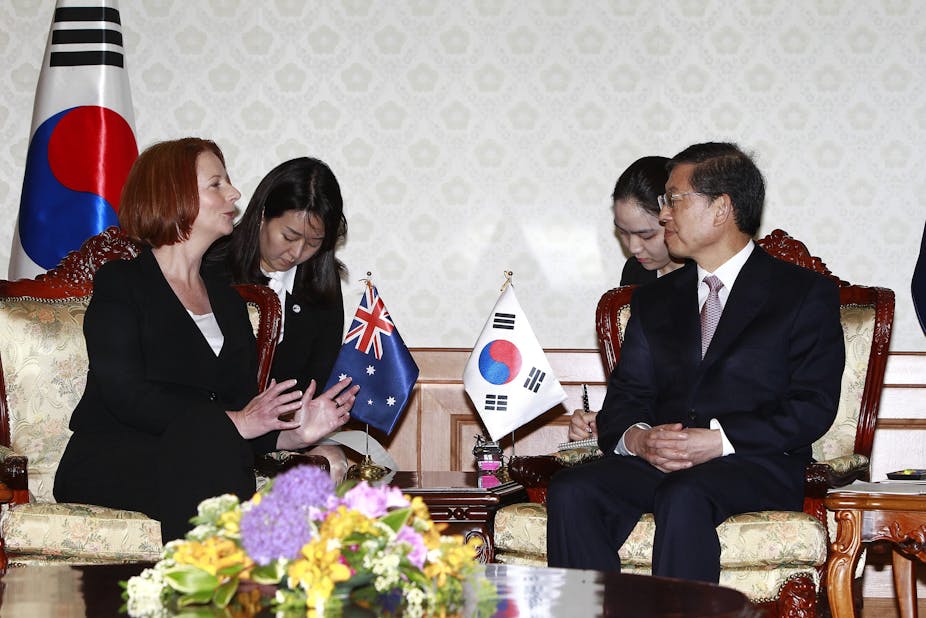With the emerging discourse on the ‘Asian Century’, it has become something of a national past-time in Australia to bemoan our lack of integration in the Asia-Pacific region. As the soon-to-be-released Asian Century white paper is sure to recommend, deepening Australia’s economic ties with the major countries in the region will be essential for Australia’s future prosperity.
But Australia can already boast considerable success in one dimension of this process – the negotiation of free trade agreements (FTAs) in the Asian region. Australia has already signed FTAs with Singapore, Thailand, Malaysia, and the ASEAN, and is currently negotiating agreements with the three Northeast Asian ‘giants’ – China, Japan and Korea.
While these agreements have been lauded as critical tool to open Asian markets to trade and investment, for some of Australia’s Asian FTAs the agenda has gone beyond simple trade liberalisation.
For China, Japan and Korea, resource security is a key part of the FTA agenda, which for Australia poses significant questions over how these resource relationships can be managed.
Asian resource security and FTAs
China, Japan and Korea are resource-importing states whose economic health is dependent upon their resource security – the continuous availability of needed natural resources at reasonable prices.
While the global resource boom has been a windfall for producers like Australia, consumers have suffered as mineral and energy prices have soared. The price of petroleum has tripled, coal has increased five-fold, and iron ore seven-fold over the last half decade, posing a major resource security crisis for economies in Asia.
The three north-east Asian governments have attempted to address this crisis by negotiating “resource-related” FTAs with their suppliers in the region. Some twenty-six FTA initiatives with resource suppliers have been launched, of which eleven have been completed so far.
Five key suppliers have been targeted by all three governments, reflecting a spread of their resource import needs: Peru and Chile for copper, India for iron ore and bauxite, the Gulf Cooperation Council for oil and gas, and Australian for a wide range of natural resources.
The intention is that these FTAs can improve national resource security by extracting preferential policy commitments from supplying governments, in the form of a “resource clause”. These can include trade policies to limit the use of trade controls, bilateral technical cooperation initiatives, or special investment rules (for example, granting exceptions to Foreign Investment Review Board criteria).
By providing preferential treatment in important mining jurisdictions, these resource clauses put consumer governments and their companies at an advantage in the current global “scramble for resources”. For this reason, China, Japan and Korea have requested such clauses from all their resource-supplying FTA partners.
Competing for Australia
Obtaining preferential resource policy commitments has been one of the primary motives for north-east Asian governments to open FTA talks with Australia. Indeed, there has been a competitive dynamic to these initiatives, with each government attempting to at least match — or best — the others in negotiations with Australia.
Japan’s decision to open FTA negotiations with Australia – long resisted due to Japanese concerns over agricultural policies – was largely driven by concerns over booming Chinese resource investment in Australia. Fearing this may lock Japan out of a key resource market, the Japanese government opened FTA talks in 2005 and requested that the agreement include a resource clause granting special access for Japanese companies.
But when Australia gave Japan in-principle agreement to include such a clause in 2007, the Chinese government quickly changed its negotiation priorities and demanded Australia include a similar provision in their FTA as well. When Korea commenced FTA negotiations with Australia, it also requested – and obtained — an in-principle agreement for a resource clause to be included.
Weighing the benefits for Australia
What does this three-way race for a resource-related FTA between Japan, China and Korea mean for Australia? The consequences can best be described as mixed.
On one hand, the economic benefits of the situation seem obvious. The urgent desire of Northeast Asian governments to sign resource-related FTAs should improve the prospects of completing such agreements. It may also make it easier for Australian negotiators to win reciprocal concession in other areas of interest, such as agriculture and financial services.
But on the other, allowing such clauses in FTAs also carries risks. If Australia makes policy preferential concessions to any one Asian customer, this may be seen as ‘playing favourites’. With both China and Japan concerned over their access to the Australian mining sector, signing such an agreement may improve relations with one customer at the cost of those with the other.
The awarding of preferential policy concessions in FTAs also clashes with the most-favoured-nation principle embedded within the World Trade Organisation. It may also distort Australia’s resource relationships in Asia by prioritising trade and investment with one partner over another.
Indeed, the Australian government has so far been been sensitive to these risks. It has refused all Northeast Asian requests for preferential policy concessions in negotiations, and has insisted that any resource clause should not interfere with the ‘normal working of the market’.
However, Australia’s refusal to play favourites on resources may also be responsible for a tempering of enthusiasm amongst its north-east Asian partners to conclude FTAs negotiations. All have now been under negotiation for an extended period of time (the Sino-Australian FTA for over seven years), and none show strong prospects for being concluded in the near future.
Thus, the resource agenda in Australia’s FTA with Asia is something of a double-edged sword, and will need to be creatively managed if the regional trade agenda is to be successfully advanced in the coming years.
This article is an abridged version of Wilson, J.D. (2012). Resource security: a new motivation for free trade agreements in the Asia-Pacific region. The Pacific Review, 25(4): 429-453.

